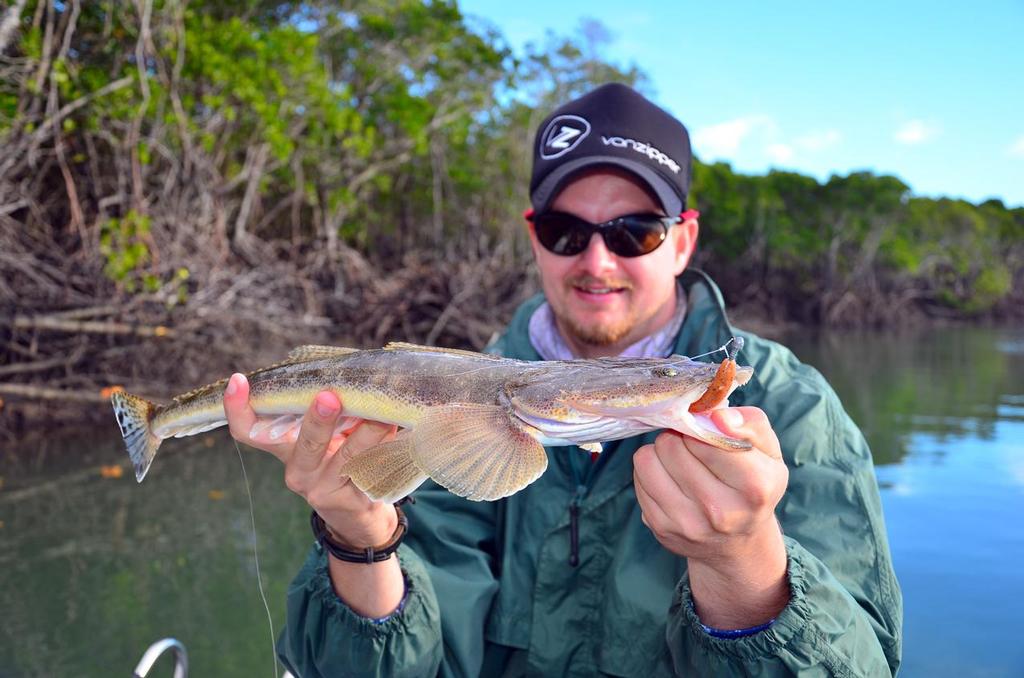Cool water tactics in the north- Flicking for flathead
by Lee Brake on 6 May 2013

In the south flathead are sand dwellers, but in the north they love muddy mangrove banks, as long as there are drains flowing from them. Lee Brake
Here in central and north Queensland we are currently going through a transition period where, as temperatures change, anglers need to adapt their approach to maximize their success. Lee Brake explains.
As the nights being to cool and the days get shorter, it’s time to look to a few of our more traditional cool water species. Flathead, big bream, whiting, grunter and pelagics are all prevalent at this time of year, and while barra and jacks are still about, getting them to bite will become harder.
For this reason, if you’re like me, you’ll adapt your approach to target these more numerous and active cool water species.
Flathead are a personal favourite species at this time of year, because they are just so easy to catch. My favourite technique involves fishing the falling tide around the flats near the mouths of estuaries. As the water drains from the flats, flathead will congregate in drains and along any sharp drop-off ledges. There they will lay, usually buried in the bottom and waiting in ambush. Any bait that comes off the flat will then face a series of living landmines just waiting to explode from below and snatch a feed.
The best way to take advantage of this is to use 3-4' soft plastics hopped slowly over the bottom. It’s one of the easiest and most productive forms of lure fishing and is a great way to introduce new anglers to soft plastics.
Timing is important, like flats fishing for barra, nothing much will happen until the water drains from the mangrove roots and forces the bait to begin exiting the protection of the flat, usually via drains. More often than not this won’t happen till about half tide out, but it can depend on the bank you are fishing. Obviously, higher banks will drain quicker, so it pays to have a game plan and cover ground in a way that puts you in the right place at the right time.
Once you’ve found the bank you want to fish, take your time and work your way along slowly, making sure you focus your casts on key, fish-holding points. I like to use the electric motor and fish my way along the entire bank slowly, but when I come to a drain mouth, I’ll hold in the spot with a 'plonk' (lead weight on a rope) and pepper it hard before moving on.
Using softies for flathead can be very different from chasing barra and jacks and has a lot of similarities with bait fishing. The technique is simple. Using light spin tackle, cast right up onto the flat, take up your slack and hop the lure back by employing small upward twitches of the rod tip followed by a pause and a small wind to take up the slack. Repeat until you're back to the boat and try to target any drop-off or drains in the mud/sand.
Flathead will rarely take a moving lure and more often then not with take the plastic as it comes to rest on the bottom after a hop. Often you’ll simply go to take up the slack and will find the line goes tight as the 'lizard' swims off with your lure. If you strike instantly upon feeling this weight, you’ll usually pull the lure straight out of the fish’s mouth. Instead, I like to point the rod tip at the fish in order to take the pressure off the line and allow it to get a good hold on the lure as it turns and swims away, and only then will I strike! If you keep the pressure on or strike immediately, most times the lure will simply pull free as the fish turns away from you. It takes practise and restraint, but will equal a lot more hook-ups. It’s also a lot of fun. Often I’ll feel the weight, announce that 'there’s one' and then we’ll watch as the braid moves through the water, mouthed by a cruising flathead. Once I’m sure he has a good grip, I’ll slowly raise the rod and, all going to plan, the tip will gradually load up and the fish will light up and go for a hard run!
Tackle choice makes a big difference when targeting flathead in this fashion. Light braid and leader is essential for feeling that exact point when the fish has taken the lure and for judging when you should strike. I like 6lb braid and 15lb leader. Rod choice is also imperative. You don’t need to spend a fortune, but a graphite rod around 7’, 2-4kg with a fast action is ideal. You want a very light tip that will load up gradually without causing the fish to spit the lure. Graphite is also important for feel and imparting lure action. Reel choice is less important, but a smooth drag will help keep hooks in place when using light line and fine gauge hooks. Either a 1000 or 2000 size spin reel will suffice.
Lure choices are broad and varied, but look for a 3-4' jerkshad in either silver or pink to get you started; grub tails are also effective.
All in all, flicking for flathead is an easy and efficient way to have fun and catch a feed. If you’re after a few for the table, 45-55cm fish are great eating and have a high flesh yield. Like big barra, try to release big fish, as they are likely females about to breed.
Fish hard and stay safe.
If you want to link to this article then please use this URL: www.sail-world.com/109178